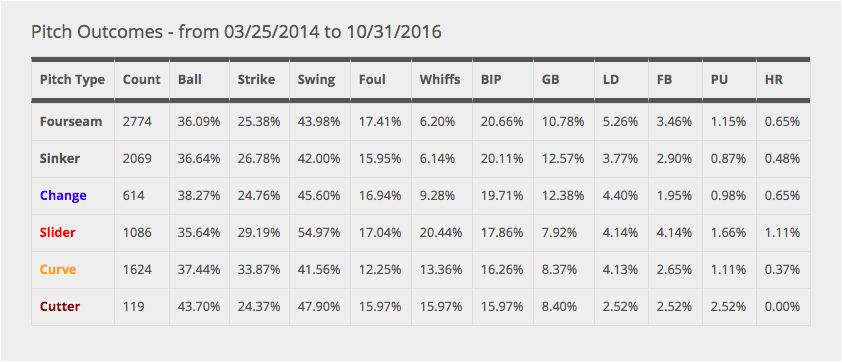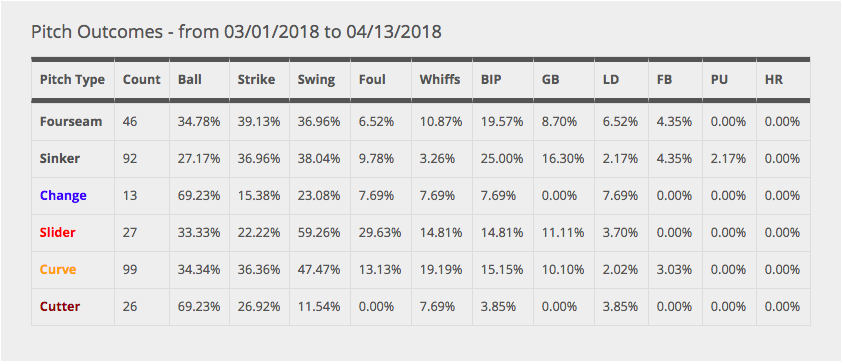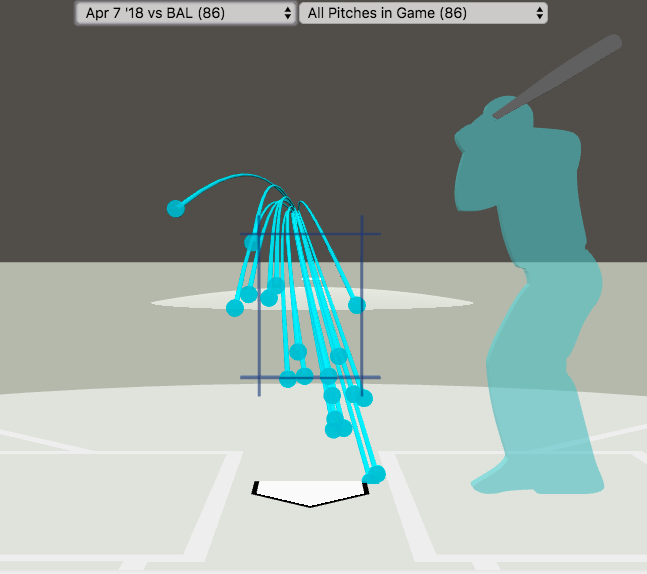Sonny Gray always carried quite the arsenal of pitches. Four-seam, sinker, cutter, changeup, slider, curveball, he’s known for changing grips, being crafty, and getting the best from every offering. Due to his lack of size and lower velocity, Gray has created a profile that uses these pitches to get ground balls, limit home runs and hard contact. However, with power growing exponentially league-wide, Gray finds himself coming off a few consecutive seasons with a long-ball issue. It is easy to blame this problem on the launch angle revolution currently spanning across all 30 teams. Many pitchers have found themselves falling victim to a rise in fly balls and home runs due to players increasing their launch angle and changing their swing planes. The league approach to hitting the ball in the air affected Gray, but other changes in the profile coincide with this skills decline.
To understand the full picture of Sonny Gray, one must begin at Vanderbilt. A top college arm known for an exceptional breaking ball, Gray was undersized at a big market baseball school with enormous potential. At the time, it was unclear if the breaking ball was a curve or a slider, but everyone knew it was filthy. After being drafted highly by the Athletics, he made his way up to the bigs by 2013 without any significant success in the minors besides giving up only 13 home runs in 53 total starts. Scouts viewed Gray as a ground ball generator without much strikeout upside. He proved this throughout his first two very successful major league seasons with the Athletics. In his first taste during 2013 and through the 2014 season he relied mainly on his fastball, sinker, and curveball. These three pitches worked wonders on the ground ball rates, all accruing over 50% GB% in his first three seasons.
In May of 2015, Sonny Gray fell in love with his slider, and it’s easy to see why. This pitch was by far his best swing and miss option. The whiff percentages on his slider were incomparable to everything else in his repertoire. His use of the pitch intensified and Gray posted a career-high SwStr% in 2015. He developed another plus pitch, in the slider, to pair with three excellent ground ball options. Unfortunately, he experienced injury issues in 2016, and the slider faltered. Giving up 5 HR in only 218 uses of the pitch, Gray had a lost year of development. Heading into last season at 27-years-old, he had a lot of catching up to do.
Gray was able to achieve much of the success he had shown in the past with the curveball and slider. In 2017, he finally started to transition down the path of utilizing his secondary offerings much more. Gray moved to the sinker as his dominant pitch, dropped the four-seam usage, and increased the frequency of sliders and changeups. While the HR/9 did decrease significantly, he was not able to pull it back under a solid 1.00, which was a skill he had possessed earlier in his career. However, the home run spike was predictable when looking back at the repertoire.


These two tables make it clear that the decreased usage of four-seam fastballs was warranted. This offering had the 2nd highest HR% of any pitch, 2nd lowest whiff%, highest ball-in-play%, and 2nd highest FB%. All of these stats take away from Gray’s skills of limiting home runs, generating swinging strikes, and keeping hits on the ground. Even with these changes, the HR/9 did not drop to a level that was considered above-average. Relying more heavily on the slider and change may have seemed like a good idea, but these two pitches had the two highest HR% in his entire repertoire from 2014-2016. His slider had always been one of his worst pitches for fly balls, but he improved the pitch a great deal last season. He was able to decrease the FB% on the slider from 4.14% to 2.1%. The whiff% of this offering also increased from an already high 20.44% to 22.41%. Gray was able to use a pitch that gave up a ton of fly balls, and home runs comparative to his other offerings, and fix both issues in one season by also cutting the HR% on this pitch in half.
Another noticeable change in these tables is his cutter usage. From 2014-2016, Gray threw 119 cutters with a near 16% whiff rate and 0 total home runs. Coming off an injury-riddled season, or perhaps coming from the organization, he oddly scrapped the pitch in 2017. He’d never thrown this offering a ton before, and it could have just been a fastball with extra movement or sinkers on a different plane, but now in 2018, we see him utilizing this pitch in a new way. Since moving to the Yankees, Gray has thrown 53 registered cutters on Brooks Baseball. Not only this, but the curveball usage is also skyrocketing. Ever since his final three 2017 starts, utilizing the Uncle Charlie has been a staple. So far he has thrown a curveball more than any other single pitch this season. It is generating more whiffs, strikes, ground balls, and swings than ever. Another benefit from this change is how he has been playing it off the rising four-seamer to achieve more whiffs on that offering.

Overall, it seems that Sonny Gray is putting together everything that makes him special as he continues to struggle out of the gates. Judging on the profile of increased curveballs, more fastball whiffs, fewer home runs and fly balls on the slider, this should be a career year. Extreme spin on his curve makes the high-heat harder to recognize and ultimately is leading to hitters swinging and missing at more pitches overall due to the deception. The success he showed with the slider last year hasn’t been as prevalent yet this season since he is bringing the curveball back into the forefront. When necessary, the slider can still be used as his best whiff% pitch because it always has been. Bringing the cutter back will cause him to miss more barrels with the late break he achieves and could also allow him to use the changeup less and rely on his other breaking-balls for the velocity gap. Sonny Gray has been a good pitch for some time. He has multiple 200 IP seasons under his belt with a devastating combination of ground balls, strikeouts, decent command, and expansive repertoire. Everything screams ace with this 28-year-old despite his lack of size and elite velocity. Combining all of the things that make him great this year will be a key for him, and I believe it starts by him utilizing his secondary offering in the way he has been working on since the beginning of last season.

What I have seen thus far is an increased usage of curveballs vs. LHH which could be a Larry Rothschild tactic to help Gray neutralize the other batter’s box more in a lefty friendly Yankees Stadium. This pitch drops right into the left-hander’s feet and could help him survive the AL East better, even though he has had reverse splits over the course of his career. Sonny Gray is continually evolving as a pitcher. He is only 28-years-old on a team with excellent pitching development who knows how to get the best out of their pitcher’s best. Tanaka’s splitter, C.C.’s breaking-ball, Severino’s fastball, have all be exploited and evolved by Rothschild and their staff. Gray could be the next in line to benefit from this and turn into the ace that has always been within the profile by achieving even more whiffs on the curveball and eventually striking out more than one batter per inning. Worry about this small sample size is an overreaction given his track record and the changes he has already shown thus far. Gray has a 1.000 BABIP on sliders and cutters, no home runs allowed, and a continuation of his career-best SwStr% from 2017. So far he has thrown 290 registered pitches on Brooks Baseball, and 43% of them are either the curve or reintroducing the cutter. The writing is on the wall for an immensely successful season from Sonny Gray, all there is to do now is wait and see.


Great write-up, Paul. That high BABIP and the difference between his ERA of 6.92 and FIP of 2.60 had me interested, but your outcome tables really highlight his pitch use changes (and Rothschild’s influence) well.
So what happened? His time in New York was pretty dismal.